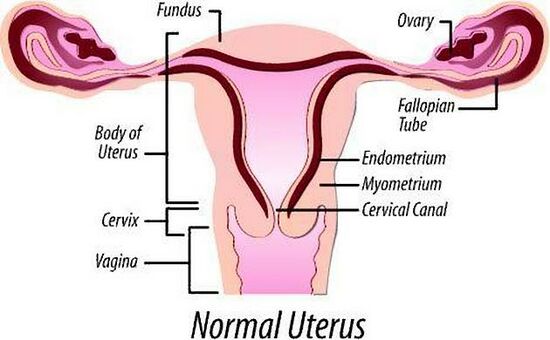Hysterectomy: Difference between revisions
No edit summary |
No edit summary |
||
| Line 25: | Line 25: | ||
# Total Abdominal Hysterectomy - Removal of the uterine body and the cervix<ref name=":1">Kives S, Lefebvre G, Wolfman W, Leyland N, Allaire C, Awadalla A, Best C, Leroux N, Potestio F, Rittenberg D, Soucy R. Supracervical hysterectomy. Journal of Obstetrics and Gynaecology Canada. 2010 Jan 1;32(1):62-8.</ref> | # Total Abdominal Hysterectomy - Removal of the uterine body and the cervix<ref name=":1">Kives S, Lefebvre G, Wolfman W, Leyland N, Allaire C, Awadalla A, Best C, Leroux N, Potestio F, Rittenberg D, Soucy R. Supracervical hysterectomy. Journal of Obstetrics and Gynaecology Canada. 2010 Jan 1;32(1):62-8.</ref> | ||
# Supracervical Hysterectomy - Removal of | # Supracervical Hysterectomy - Removal of the fundus and body of the uterus but excludes the cervix <ref name=":1" /> | ||
# Hysterectomies are associated with removal of the ovaries and fallopian tubes ( Bilateral salphingo-oophorectomy)<ref name=":1" /> | # Hysterectomies are associated with removal of the ovaries and fallopian tubes ( Bilateral salphingo-oophorectomy)<ref name=":1" /> | ||
# Radical Hysterectomy<br> | # Radical Hysterectomy<br> | ||
| Line 31: | Line 31: | ||
== Surgical Approaches for hysterectomy == | == Surgical Approaches for hysterectomy == | ||
* Abddominal Hysterectomy<ref name=":2">Aarts JW, Nieboer TE, Johnson N, Tavender E, Garry R, Mol BW, Kluivers KB. Surgical approach to hysterectomy for benign gynaecological disease. Cochrane database of systematic reviews. 2015(8).</ref> | * Abddominal Hysterectomy<ref name=":2">Aarts JW, Nieboer TE, Johnson N, Tavender E, Garry R, Mol BW, Kluivers KB. Surgical approach to hysterectomy for benign gynaecological disease. Cochrane database of systematic reviews. 2015(8).</ref> - This route allows inspection of other pelvic organs and surrounding tissue. This route is used for carcinoma or to remove a large fibroid uterus. The uterus is accessed through a Pfannenstiel( Bikini-line) incision. | ||
* Vaginal Hysterectomy<ref name=":2" /> | * Vaginal Hysterectomy<ref name=":2" />- An incision is made in the anterior vaginal wall to access the uterus and cervix. This approach is usually used for non-malignant conditions of the uterus, particularly in cases of uterine prolapse. | ||
* Laparoscopic Hysterectomy<ref name=":2" /> | * Laparoscopic Hysterectomy<ref name=":2" /> - | ||
* Robotic-assisted Hysterectomy<ref name=":2" /> | * Robotic-assisted Hysterectomy<ref name=":2" /> | ||
Revision as of 05:57, 24 May 2022
Original Editor - User Name
Top Contributors - Erika Rodrigues
Introduction
[edit | edit source]
Hysterectomy is the surgical removal of the uterus. [1]It could be performed through the abdominal route, vaginal route, laparoscopically or combined method.[2]
Indication
[edit | edit source]
- Uterine Leiomyomas[3]
- Uterine Bleeding[3]
- Endometriosis[3]
- Adenomyosis[3]
- Endometrial hyperplasia[3]
- Uterine Cancer[3]
- Pelvic Inflammatory Disease[3]
- Massive Postpartum Hemorrhage [3]
Types of Hysterectomies[edit | edit source]
- Total Abdominal Hysterectomy - Removal of the uterine body and the cervix[4]
- Supracervical Hysterectomy - Removal of the fundus and body of the uterus but excludes the cervix [4]
- Hysterectomies are associated with removal of the ovaries and fallopian tubes ( Bilateral salphingo-oophorectomy)[4]
- Radical Hysterectomy
Surgical Approaches for hysterectomy[edit | edit source]
- Abddominal Hysterectomy[5] - This route allows inspection of other pelvic organs and surrounding tissue. This route is used for carcinoma or to remove a large fibroid uterus. The uterus is accessed through a Pfannenstiel( Bikini-line) incision.
- Vaginal Hysterectomy[5]- An incision is made in the anterior vaginal wall to access the uterus and cervix. This approach is usually used for non-malignant conditions of the uterus, particularly in cases of uterine prolapse.
- Laparoscopic Hysterectomy[5] -
- Robotic-assisted Hysterectomy[5]
Pre-Op[edit | edit source]
add text here relating to the pre-operative advice
Post-Op[edit | edit source]
add text here relaAbdominalst-operative rehabilitation
Resources
[edit | edit source]
add appropriate resources here
References[edit | edit source]
- ↑ Papadopoulos MS, Tolikas AC, Miliaras DE. Hysterectomy—Current Methods and Alternatives for Benign Indications. Obstetrics and gynecology international. 2010 Jan 1;2010.
- ↑ Anbreen F, Qadir S, Naeem H, Farhat N, Ghafoor M, Hassan S. Type, time-trend and indications of hysterectomy. Gomal Journal of Medical Sciences. 2018 Dec 31;16(4):92-6.
- ↑ 3.0 3.1 3.2 3.3 3.4 3.5 3.6 3.7 Carlson KJ, Nichols DH, Schiff I. Indications for hysterectomy. New England Journal of Medicine. 1993 Mar 25;328(12):856-60.
- ↑ 4.0 4.1 4.2 Kives S, Lefebvre G, Wolfman W, Leyland N, Allaire C, Awadalla A, Best C, Leroux N, Potestio F, Rittenberg D, Soucy R. Supracervical hysterectomy. Journal of Obstetrics and Gynaecology Canada. 2010 Jan 1;32(1):62-8.
- ↑ 5.0 5.1 5.2 5.3 Aarts JW, Nieboer TE, Johnson N, Tavender E, Garry R, Mol BW, Kluivers KB. Surgical approach to hysterectomy for benign gynaecological disease. Cochrane database of systematic reviews. 2015(8).







